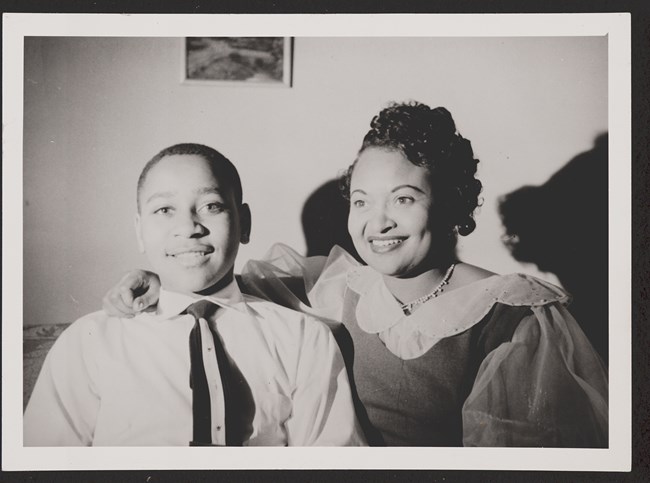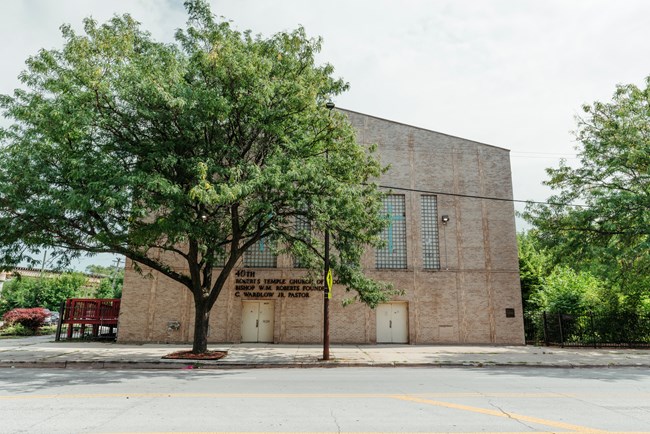IntroductionIn August and September of 1955, a series of tragic events in rural Mississippi and Chicago’s South Side brought a 14-year-old African American boy’s lynching to national attention. Emmett Till’s kidnapping, murder, and funeral marked a turning point in America’s understanding of racist violence. Mamie Till-Mobley’s courage in showing the brutality done to her son highlighted racial injustice and helped inspire the modern civil rights movement.
NAACP Records, Library of Congress Mississippi BeginningsMamie Till-Mobley (née Carthan) was born in Webb, Tallahatchie County, Mississippi. At the age of two, her family relocated to the Chicago Area, eventually settling in Argo-Summit. Their move was part of the Great Migration, an exodus ignited by violence and widespread economic, social, and political disparities that African Americans were experiencing in the South. After graduating from high school, she married Louis Till. Their only child, Emmett, was born in 1941. Known as a fun-loving jokester, Emmett spent his childhood in Argo-Summit, then Chicago’s South Side. Though polio left him with a stutter, his illness did not diminish his enthusiasm for life.Everything changed in 1955, the summer before Emmett was to enter 8th grade. That year, Emmett begged to go south to spend part of his vacation with family in Mississippi. A Visit to the Delta
Emmett arrived by train to Mississippi on Sunday, August 21, and went to stay at the home of his great uncle Moses (Mose) Wright outside of Money. Deadly NightWhen Carolyn’s husband Roy Bryant heard of Emmett’s apparent interaction with his wife, he and his half-brother J.W. Milam sought to punish him. In the dark of night on August 28, the two men drove to Wright’s home. They demanded Emmett at gunpoint and he was reluctantly turned over to the men. After taking Emmett, the two men beat and shot him, before throwing his body in the Tallahatchie River. Three days later, Emmett’s mutilated body was found floating in the river and retrieved near Graball Landing in Glendora, a cotton gin fan tied around his neck with barbed wire.Earlier, Wright reported Emmett’s abduction to authorities, so Bryant and Milam had already been arrested for the kidnapping (to which they admitted). The discovery of the body meant the two men would now be charged with murder. 
Battiest Photography / National Trust for Historic Preservation All Eyes on Chicago
After learning of the horrific murder of her only child, Mrs. Till-Mobley demanded Emmett’s body be returned to Chicago. Her next request turned private grief into the grief of the nation. Knowing the powerful effect it would have, his mother insisted on an open-casket funeral for Emmett. All eyes turned to Roberts Temple Church of God in Christ for the viewing and funeral in September. Confronted with the image of Emmett’s battered body, the nation could no longer ignore the deadly impacts of hatred and racism. 
NPS / Jay D. Johnson Seeking JusticeTwo weeks after the funeral events, eyes were back on Mississippi. The murder trial for Roy Bryant and J.W. Milam took place at the Tallahatchie County Courthouse in Sumner. Journalists, photographers, civil rights organizers, politicians, and curious spectators from all over the country descended on the segregated courtroom, where Southern race relations were on full display.An all-White, all-male jury was selected. Two local Black men, Moses Wright and Willie Reed, offered groundbreaking testimony by taking the stand against White defendants. Mrs. Till-Mobley also testified. Despite what appeared to be overwhelming evidence of the defendants’ guilt, the jury returned a not guilty decision after one hour of deliberation. The verdict caused international outrage. Bryant and Milam later openly confessed their guilt for a magazine story, but double jeopardy prevented them from being retried. However, from tragic loss came resistance. Mrs. Till-Mobley and other family members continued to seek justice and fight for equality. Many activists, including Rosa Parks, later identified the Emmett Till injustice as a catalyst for their involvement in the civil rights movement. Though justice for Emmett’s murder has never been realized, the legacies of Emmett Till and Mamie Till-Mobley remain a source of inspiration. Congress passed a bill in 2022 making lynching a federal hate crime. The landmark legislation bears his name: The Emmett Till Antilynching Act. Learn More
|
Last updated: September 26, 2024
